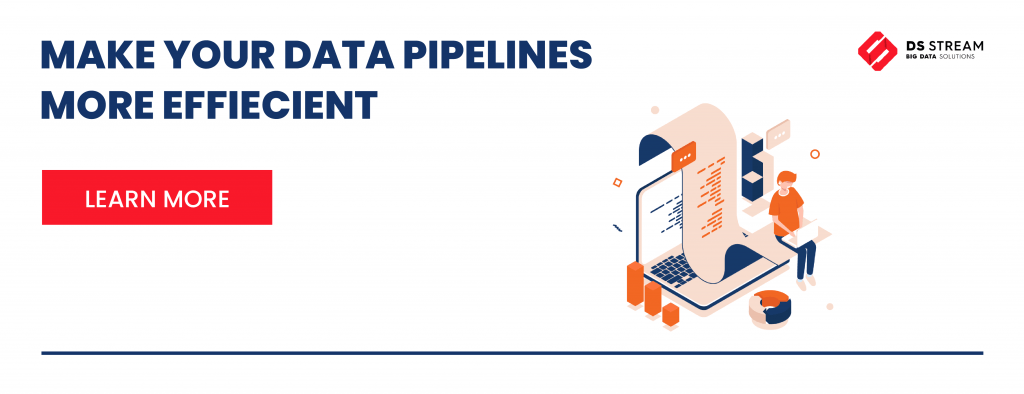
-
31 January 2022
- Data Pipeline
How does your company ensure the quality of the information used on a daily basis to improve the efficiency of your business? Performing data validation is crucial for the success of any data-driven business. Learn more about data validation techniques and make sure you use only high quality datasets.
Companies use data in numerous ways – for automation, analytics, personalization etc. In order to actually benefit from the processes powered by business data, you need to ensure that you have accurate, high quality data. Therefore, you have to set the standards for data validation in your organization. If you have never paid attention to your data quality before, you should read about data validation techniques and approaches. Make the most of your data!
Data validation –what is it?
Data validation is a process of examining the quality of business data. Data quality validation includes checking the accuracy of the business information collected by your company, but also its completeness and consistency (sometimes data of too poor quality can’t be added to datasets, or it requires fixing). Data validation procedures can be considered part of the data cleaning process. Before data can be fixed or excluded from the dataset, you have to assess whether your data is of high or low quality. During data validation, you learn if your data is complete (there are no blank or null values), unique (the values are not duplicated), accurate, has the expected format, size and does not contain any unaccepted special characters.
Why should you use certain data validation methods?
Just imagine that after many years of making decisions based on a particular set of reports, you learn that all of them had been wrong due to poor quality of data used for reporting? The worst part is that your decisions might have caused lost resources or reduced business efficiency. That can actually happen to you if you don’t check the accuracy, completeness and uniqueness of your business data.
Data validation is necessary in order to:
- Prevent delays on the various projects in your company.
- Reduce the risk of making poor business decisions.
- Increase the efficiency of your organization.
- Protect your application and prevent downtimes.
- Reprocess your pipelines from failures.
In the world of business, we make decisions every day. Without good data verification and validation methods, we cannot be sure if our decisions are actually based on reliable data. But how do you conduct data validation?
How to validate the data gathered by your company
What database validation methods can you leverage in your company? Choosing the solution that will best suit your company’s needs is not easy. There are considerations – your budget, business requirements, employees experience etc. So, how can your data be validated?
Scripting
If you hire professionals experienced in performing data validation, they can simply write specific scripts for the validation process using one of the scripting languages (for example Python, which is often used for data science). While this method may seem simple, it could also be time-consuming (the script has to be written and alerts should be created in order to verify results automatically) and inefficient for very complex processes. It can be a good fit for smaller tasks, though.
Open source tools
Leveraging open source tools also requires employing tech-savvy staff with some experience in data validation and coding skills. Such solutions are free to use and modify in order to make them more suitable for your company. If the chosen tool is cloud-based, you can even save money on infrastructure.
Enterprise tools
Enterprise data quality validation tools are high quality, effective programs that can check your business information quality very fast. Data validation is often only one feature of such software. These tools can also be capable of fixing data straight away. Enterprise data validation tools are mostly very stable and secure, but they require a specific infrastructure. Using them usually costs more than validating data with open source tools.
Both open source and enterprise tools can be divided into a few categories. Examples are:
- Orchestrators – Airflow (Composer in Google Cloud)
- ETL processes – Data Fusion (Google Cloud), Data Factory (Microsoft Azure)
- Data exploration – Dataprep by Trifacta (Google Cloud)
- Machine Learning in real-time – e.x. anomaly detection – Seldon
In general, if we are able to write data quality tests in Python, we have an orchestrator and our solution is efficient enough – we are good to go. Lack of experienced developers may be a reason to choose no-code open source tools, like Dataprep in Google Cloud. In more complex projects, where all the tiniest changes or errors might cause a huge impact, the best idea would be to reach out for advanced enterprise tools or Machine Learning based tools (especially when we deal with real-time data).
5 data validation techniques you need to learn more about
The most important and general good practice is to design your data workflow in a way that will enable you to spot issues quickly and solve problems efficiently, as they appear. Performing checks at the very beginning of the data life cycle and later allows you to ensure the high quality of your gathered and processed information. No matter what tools you choose, you should make sure that your company is following the best popular practices for data validation. Below, we describe five data validation techniques worth knowing.
1. Source system loop-back verification
Source system loop-back verification is one way to validate data. You need to go through the aggregate-based verification of your subject to see if it matches the data source. This allows you to make sure that information pulled from one system matches the same data used in a different system and that there are no issues. This is a simple, yet rarely leveraged, data validation technique.
2. Ongoing source-to-source verification
Data validation techniques in SQL enable business users to compare two data sources by joining them together and searching for differences. It is a good validation method if you have some problems that affect data quality in multiple source systems, or if you need to compare similar information at different stages of your business life cycle. However, it is not always possible. Depending on the volume of your data, it could turn out expensive or computing-power consuming.
3. Data certification
The best way to ensure the high data quality of your datasets is to perform up-front data validation. Check the accuracy and completeness of collected data before you add it to your data warehouse. This will increase the time you need to integrate new data sources into your data warehouse. By leveraging this data validation technique, you will gain certainty that your business information is truly reliable.
4. Data-Issue tracking
How can you validate the data you gather to ensure the highest quality? You can track all of the potential issues in one place and spot errors that often repeat (like number of duplicated and blank values, incorrect format of data, different than expected size of a field, incompleteness). This way you know what subject areas tend to be riskier than others, and you can apply some preventive solutions to ensure that you will be operating only on high quality data.
5. Statistics collection
If you maintain statistics for the full life cycle of your data, you can set special alarms for unexpected results and receive notifications when they occur. For that purpose, you can rely on metadata from your transformation tool or use a statistics collection process developed by your in-house professionals. So, for example, if your regular loads have a specific size and one day they are significantly smaller or larger, you will receive an alert, and you will be able to react accordingly.
Data quality validation – challenges
Data validation may be challenging. If you are running a big company, you certainly have multiple databases, data sources and systems through which your business data is distributed. Apart from that, validating the data format can require a lot of time, especially if you possess large databases. In that case, manual data validation can be really difficult. Fortunately, there are many input validation methods you can apply in your systems and data validation good practices you can follow in order to ensure the high quality of your datasets.
Are you still not sure how to validate your data? We’ll be happy to help you with that challenge! Contact us, and we will analyse your business needs and suggest the best solutions.
Check out our blog for more details on Data Pipeline solutions:


